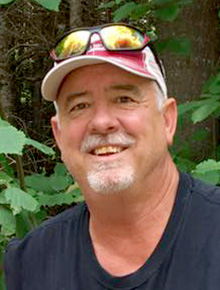
I figured it was time to give you all an update on my newest Labrador puppy, Ghost. He just reached the 9-month mark and is doing all the things puppies like to do.
If you give him a free minute, he will run down the hall and hide under my bed and then destroy anything he found there or took with him on his way there. He is so big he can barely fit under there but squeeze he does.
Most of the time his destructions are mild. The biggest loss was a 1-week-old pair of hand-knitted wool socks I had worn only once. I even put them up on the dresser and he found them and had a “Big And Rich” time in puppy terms. He did chew the top off of a pretty good pair of ankle high hunting boots. Good thing my pants still cover the damage.
I have spent the last few winter months working on “here,” “sit” and “heel.” This was done inside my shed. He has graduated to the point where he will walk at “heel” off lead with pretty good success.
What I would like to share today are some other very important things you need to be doing as that dog grows from the puppy stage to an adult dog which happens in about one year’s time.
I have been socializing him at every opportunity. I have a saying that “… anything a puppy is properly exposed to in the first six months of their life, they will most likely not be scared or timid of for the rest of their life.” This can be loud noises, thunder, train whistles, shop vacuums, gunfire, fireworks and other things that many dogs will freak out from.
There is a proper way and many terrible ways to do these introductions. When it comes to loud noises like those listed earlier, it takes more than one experience to be successful.
I start my shop vacuum in another room. I gather up my puppy in my arms and starting at a long distance, I will slowly walk toward the noise. I am petting him and gently talking to him.
I say, “What is that sound? Should we go check it out?” At the first sign of apprehension, I start backing up and the lesson is over for the day. It might take a few efforts, but in no time he will think the noise is no big deal.
The same method works for introduction to gunfire. I leave the puppy in a kennel in the truck with the windows closed. I walk about 100 yards away and fire a gun in the opposite direction of the truck. If you have a helper, you can sit with the little one and have your helper shoot the gun. If the puppy starts to get nervous, back away; that session is over for that day.
It took about four exposures to gunfire, each time with the gun a little closer, and soon Ghost would sit right next to the trap thrower while my friends did their best to dust the clays as they were propelled skyward.
When they are no longer afraid of the sound of a gun, I then add in some fun bumper retrieves. As a helper shoots the gun, I would throw a bumper in a slightly different direction. The excitement of the retrieves is then associated with the sound of the gun, and as a result, all of my dogs get excited when they see a gun.
Intro to gunfire is certainly not the only socialization your puppy needs. Controlled contact with other people, other dogs and new places is also important. Dog introductions need to be done with both the puppy and the introduction dog on a leash.
You never really know how the new dog might react when an energetic puppy starts wanting to play. I saw the results when the puppy was cut loose with a new dog and ended up with a big dog canine puncture wound right through the top of its nose into the nasal cavity of the little one.
Surgery fixed up the little guy, but there was a serious lesson learned by that new owner that day. Not all of those “gone bad” introductions end up with a good outcome.
With no prior introductions, the puppy had just arrived two days earlier, an associate of mine had the neighbor’s dog bust loose from their back yard, and within 15 seconds her puppy was killed by the neighbor dog.
It is normally not that serious of an outcome, but dog introductions are very important and then need to be done the right way.
In a few weeks I will share Ghost’s first experience in the water. It was a grand affair and more than a few laughs were had. Stay tuned.
Scott Rall, Worthington, is a habitat conservationist, avid hunting and fishing enthusiast and is president of Nobles County Pheasants Forever. He can be reached at scottarall@gmail.com. or on Twitter @habitat champion.


